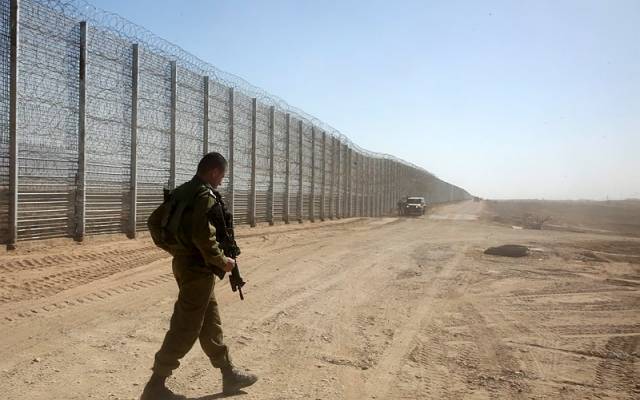As readers may already know, the borders of the modern-day State of Israel are but a fraction of the true biblical borders of the Promised Land.
By Rabbi Ari Enkin, Rabbinic Director, United with Israel
“Eretz Yisrael” (the Land of Israel) is the traditional Jewish name for the Promised Land and is first found in the Book of Samuel.
As we read in the book of Genesis, Eretz Yisrael was promised by God to Abraham and his descendants through his son Isaac, and it is an everlasting promise that can never be annulled. Where exactly this Promised land is, however, and what its borders are, is the subject of this article.
The borders of Eretz Yisrael are found primarily in Genesis 15, Exodus 23, Numbers 34, and Ezekiel 47 though they make additional appearances as well. As readers may already know, the borders of the modern-day State of Israel are but a fraction of the true biblical borders of the Promised Land.
The importance of knowing the exact borders of the Land of Israel is important for a number of reasons. For example, 26 of the 613 mitzvot (commandments) of the Torah apply only in the Land of Israel. Such laws include all those relating to the Holy Temple (which unfortunately will not be relevant until the Messiah comes), the requirement to separate tithes from produce, leaving a portion of a field for the poor (along with other field-related mitzvot), the requirement to use only “old wheat” (a lesser-known commandment known as “yashan”) and so many more.
In fact, a person can compel his or her spouse to move to the Land of Israel! As such, we need to know where these laws must be observed. Brooklyn? No. Melbourne? No. Amman, Damascus, or Beirut? Maybe!
Let’s begin with Genesis 15:18-21. The Torah tells us: “On that day God made a covenant with Abram and said, To your descendants I give this land, from the river of Egypt to the great river, the Euphrates— the land of the Kenites, Kenizzites, Kadmonites, Hittites, Perizzites, Rephaites, Amorites, Canaanites, Girgashites and Jebusites.”
One can see from the geographical listing (“from the river of Egypt to the Euprates”) that the Land of Israel is a huge territory, essentially going from Egypt to Iraq, as well as from the fact that it covers an area belonging to 10 different nations.
More precise geographical borders are given in Exodus 23:31. “I will establish your borders from the Red Sea to the Mediterranean Sea, and from the desert to the Euphrates River. I will give into your hands the people who live in the land, and you will drive them out before you.”
Notice how the Red Sea and the Euphrates are mentioned to define the southern and eastern borders of the full land promised to the Jews.
The “Red Sea,” corresponding to the Hebrew “Yam Suf,” refers to the body of water known in ancient times as the Erythraean Sea. Erythraean is “red” in Greek, hence the name the “Red Sea.” However, the term “Erythraean Sea” denotes all the waters surrounding Arabia and not merely the waters at the southern port of Israel that are known today as the “Red Sea.” It emerges, therefore, that all of Saudi Arabia may very well be part of the land promised to the Jewish people.
The borders of Numbers 34 and Ezekiel 47 are the most familiar as they somewhat resemble the borders of the modern State of Israel:
“God said to Moses…When you enter Canaan, the land that will be allotted to you as an inheritance is to have these boundaries: Your southern side will be the Desert of Zin…and the southern end of the Dead Sea…Your western boundary will be the coast of the Mediterranean Sea…For the northern border…run a line from the Mediterranean Sea to Mount Hor…For your eastern border…the slopes east of the Sea of Galilee…down along the Jordan and end at the Dead Sea. This will be your land, with its boundaries on every side.’”
According to these borders, Beirut, Damascus, and even Southern Turkey (as “Mount Hor” is quite far north) are part of the Land of Israel while the Israeli city of Eilat is not.
So why does the Torah list different borders in different passages? The answer can be found in Deuteronomy 19:8, where we are told that “God will enlarge your borders…and you will receive all the land that He promised to your fathers.”
Hence, the large borders (Genesis 15/Exodus 23) are a future promise, while the other borders (Numbers 34/Ezekiel 47), which actually do resemble the current borders of the State of Israel, are the “now” borders. So when the Messiah comes, may it be soon, you’ll be eating at kosher restaurants in Damascus, Amman, and Bagdad!
REBUILD ISRAELI FARMS DESTROYED BY HAMAS - PLANT TREES!
ISRAELI FARMERS DESPERATELY NEED YOUR YOUR HELP
Hamas tried to destroy everything. Terrorists murdered 1200 innocent Israelis. Join us in planting 12,000 trees of life to honor the victims. Send blessing to the People and Land of Israel.
“…I will ordain My blessing for you…” (Leviticus 25:4,21)
JOIN OUR CAMPAIGN TO PLANT 12,000 NEW FRUIT TREES ACROSS THE LAND OF ISRAEL!




